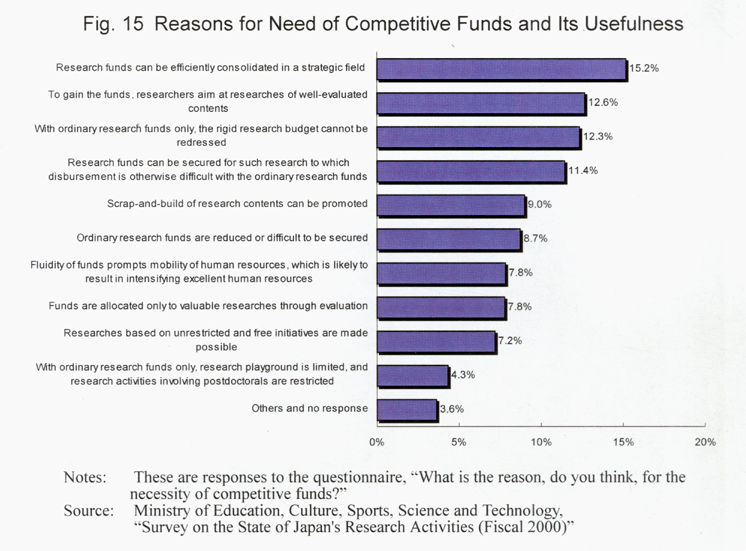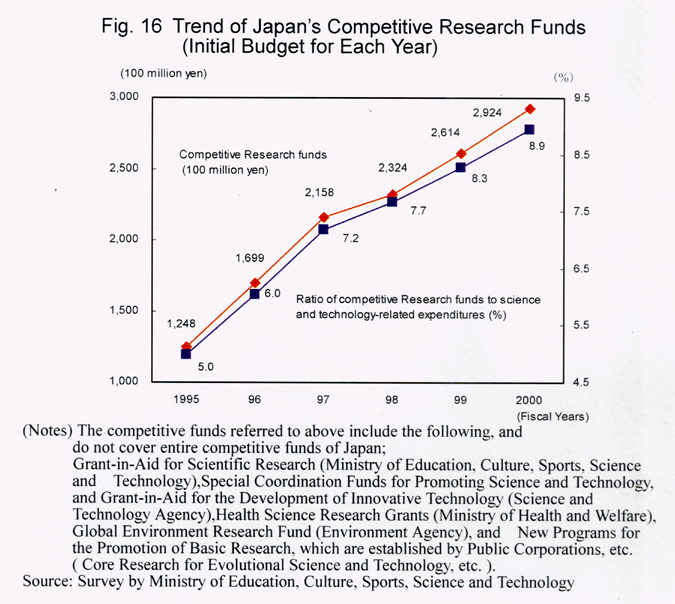| Home > Policy > White Paper, Notice, Announcement > White Paper > Annual Report on the Promotion of Science and Technology 2001 > Part1 Chapter2 Section2 2 | ||
![]() The competitive funds are selectively allocated to research
issues that have been chosen by prior evaluation. For this reason, it is an important
fund as a means of utilizing limited funds efficiently and effectively ( Fig.
15 ). Also, it is a fair and merit-based system to provide young researchers
with research opportunities.
The competitive funds are selectively allocated to research
issues that have been chosen by prior evaluation. For this reason, it is an important
fund as a means of utilizing limited funds efficiently and effectively ( Fig.
15 ). Also, it is a fair and merit-based system to provide young researchers
with research opportunities.

| (Funding Rate and Grant Size) |
![]() Regarding the extent of Japan's competitive environment, the
adoption ratio of issues is about 20% in new issues under the gtants-in-aid for
scientific research system, and less than 10% on average under the basic research
promotion system by Special Public Corporations, etc. Thus the competitive funds
of the public sector are placed in a very severe position.
Regarding the extent of Japan's competitive environment, the
adoption ratio of issues is about 20% in new issues under the gtants-in-aid for
scientific research system, and less than 10% on average under the basic research
promotion system by Special Public Corporations, etc. Thus the competitive funds
of the public sector are placed in a very severe position.
![]() The quantity of the competitive funds that researchers wish
to have for their researches is relatively medium-sized, in the range of 5 to
20 million yen. It is important to work out a system that reflects the need of
these researchers.
The quantity of the competitive funds that researchers wish
to have for their researches is relatively medium-sized, in the range of 5 to
20 million yen. It is important to work out a system that reflects the need of
these researchers.
| (Amplification of Competitive Funds) |
![]() During the period of the First-term Science and Technology
Basic Plan, the competitive funds had been amplified about 2.4 times in the amount,
from 5.0% (fiscal 1995) to 8.9% (fiscal 2000) in the ratio to the science and
technology related expenditures ( Fig.
16 ).
During the period of the First-term Science and Technology
Basic Plan, the competitive funds had been amplified about 2.4 times in the amount,
from 5.0% (fiscal 1995) to 8.9% (fiscal 2000) in the ratio to the science and
technology related expenditures ( Fig.
16 ).

![]() Under the Second-term Science and Technology Basic Plan, the
amplification of the competitive funds is to continue, subject to the selective
and efficient allocation of resources. The increase in its size and ratio is
expected.
Under the Second-term Science and Technology Basic Plan, the
amplification of the competitive funds is to continue, subject to the selective
and efficient allocation of resources. The increase in its size and ratio is
expected.
| (Use of Grant) |
![]() The Second-term Science and Technology Basic Plan provides
that in course of doubling the competitive funds, the research expense for young
researchers should be increased selectively, and aggressive applications by young
researchers for competitive funds in general should also be encouraged.
The Second-term Science and Technology Basic Plan provides
that in course of doubling the competitive funds, the research expense for young
researchers should be increased selectively, and aggressive applications by young
researchers for competitive funds in general should also be encouraged.
![]() In addition to the promotion of joint researches and interdisciplinary
researches in the past, it is hoped that a system to support young researchers
in elevating their independence will be established in the future.
In addition to the promotion of joint researches and interdisciplinary
researches in the past, it is hoped that a system to support young researchers
in elevating their independence will be established in the future.
![]() The indirect costs refers to those allowed for expenses necessary
for managing research institutes in respect of costs that are associated with
conducting researches. They are intended for the efficient and effective use
of competitive funds. The expense is allocated, at a certain ratio to research
expenses, to the research institutes to which the researchers who have obtained
competitive funds belong.
The indirect costs refers to those allowed for expenses necessary
for managing research institutes in respect of costs that are associated with
conducting researches. They are intended for the efficient and effective use
of competitive funds. The expense is allocated, at a certain ratio to research
expenses, to the research institutes to which the researchers who have obtained
competitive funds belong.
![]() The efficient and flexible use of the funds by research institutes
will help improve research environment and strengthen the functions of the research
institute as a whole. It is expected that the indirect costs will prompt competitive
principles among research institutes and create research environment that are
attractive to researchers.
The efficient and flexible use of the funds by research institutes
will help improve research environment and strengthen the functions of the research
institute as a whole. It is expected that the indirect costs will prompt competitive
principles among research institutes and create research environment that are
attractive to researchers.
![]() In Japan at present, the introducing of the indirect costs
into research expenses is rather infrequent. Therefore, the Second-term Science
and Technology Basic Plan intend to promote such introduction, with its ratio
to research expenses aimed around 30% for the time being.
In Japan at present, the introducing of the indirect costs
into research expenses is rather infrequent. Therefore, the Second-term Science
and Technology Basic Plan intend to promote such introduction, with its ratio
to research expenses aimed around 30% for the time being.
![]() Regarding problems in executing research budgets, it is pointed
out that especially at national universities, national testing-and-research institutes
and the like, clerical procedures are complex and various restraints are imposed
due to national budgeting system.
Regarding problems in executing research budgets, it is pointed
out that especially at national universities, national testing-and-research institutes
and the like, clerical procedures are complex and various restraints are imposed
due to national budgeting system.
![]() From the standpoint of ensuring smooth researches, the system
has been improved in part. However, we look for further improvement in flexibility
in the use of research expenses such as the inter-account diversion of research
expenses, as well as the flexible carry-over of the expenses.
From the standpoint of ensuring smooth researches, the system
has been improved in part. However, we look for further improvement in flexibility
in the use of research expenses such as the inter-account diversion of research
expenses, as well as the flexible carry-over of the expenses.
![]() In order to promote the introduction of external funds, it
is important to make a broad improvement in the system with an eye to the introduction
of not only the competitive funds but also funds from industrial communities,
venture capitals and the like.
In order to promote the introduction of external funds, it
is important to make a broad improvement in the system with an eye to the introduction
of not only the competitive funds but also funds from industrial communities,
venture capitals and the like.
| Back to Top | MEXT HOME |